Karen Goetzinger is best known for her finely detailed mixed media textile constructions.
She combines her roots in quilt making and couture construction with a life-long passion for the urban landscape and architecture, Karen captures these instances through the perspective of treasured but fading memories.
In this article, part of our From conception to creation series Karen discusses her recent piece Travelling Exhibition 2. We learn how railroads and street art collide to create this stunning vision of a vanishing moment, and which materials Karen uses to create her haunting and vibrant works.
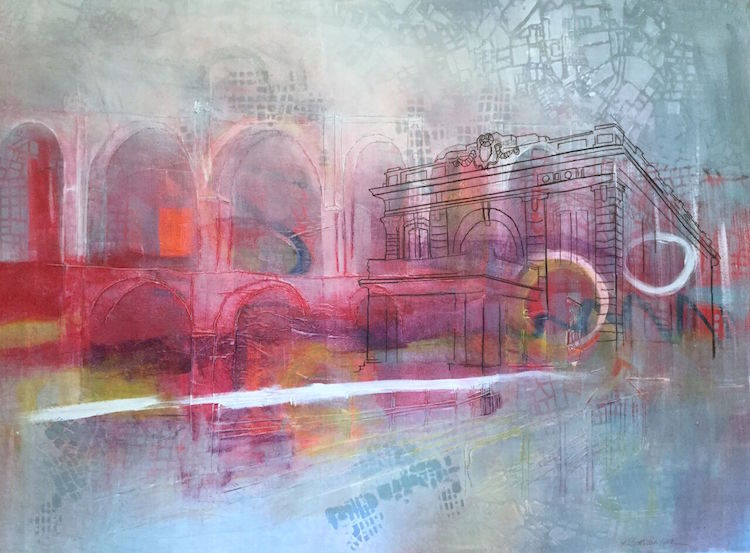
Name of piece: Travelling Exhibition 2
Year of piece: 2017
Size of piece: 30” x 40”
Materials used: Thread and acrylic paint on stretched canvas
Techniques used: Embroidery, painting, printing with hand cut stencil
A plethora of thoughts
TextileArtist.org: How did the idea for the piece come about? What was your inspiration?
Karen Goetzinger: Initially when I chose to talk about this piece, I admittedly chose it purely because I had some images of it in progress that I could share. Unfortunately, I don’t always remember to take photos of my work in progress.
However to reflect on the making of ‘Travelling Exhibition 2’ was enlightening for me in that it became clear that my process of layering thread and paint is directly related to my thought process as well and the layers of images that fill my head.
I am represented by a retail gallery in Ottawa, Ontario, Canada that is housed in a beautiful 120-year-old brick building with a history of usage by the CN railroad company.
This year to commemorate the 150th year of the Confederation of Canada, the gallery wanted to mount a railroad-themed exhibition of works by their stable of artists, given the history of the building and that currently a light rail system is being constructed that will pass through the area in which the gallery is situated.
How would I interpret this theme? Typically, I don’t enter themed shows but felt that as a represented artist I should at least give it a try. As always, a plethora of thoughts filled my head. What direction would I take? How could this fit into my current ‘Vanishing Point’ series about fading memories? Did it need to fit? Should it be a new direction that I had recently been exploring?
I have an interested in street art, as well. Not tagging but thoughtful street art. This interest was fuelled by a trip to Melbourne, Australia a few years ago. I fell in love with their designated street art laneways and the works on the side of freight cars and buildings along the railroad tracks as I took the train from Melbourne to Ballarat, Victoria.
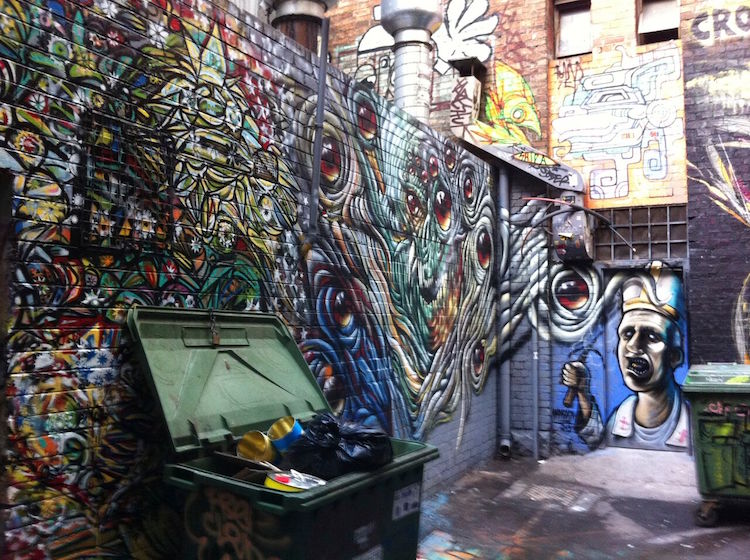
So in this case, the name of the work came long before the completion of the work. ‘Travelling Exhibition 2’ is a nod to the artworks on the side of those freight cars but also to the swiftness with which our memories can become less vivid. Initially, I thought the abstract aspect of the work would be quite prominent.
I also have a love of old architecture and derelict buildings. I have a conflicted curiosity with derelict buildings that have been abandoned and neglected over the years. Saddened by the disrepair, I am strangely intrigued about who lived there, or for what purposes the buildings had been used. They stand, in whatever their condition, as a distinct mark, a vestige of our past with many still worthy of our directed stewardship.
So, where to begin…Fading memories, street art, old architecture. Would it be possible to layer all these seemingly disparate thoughts?
What research did you do before you started to make?
I began by going back to look at my photos of street art and I also looked at images of railroad viaducts and bridges, old railway stations, and street art on the side of freight cars. I poured over a book I own that I love, Covert to Overt , about the work of artist Shepard Fairey.
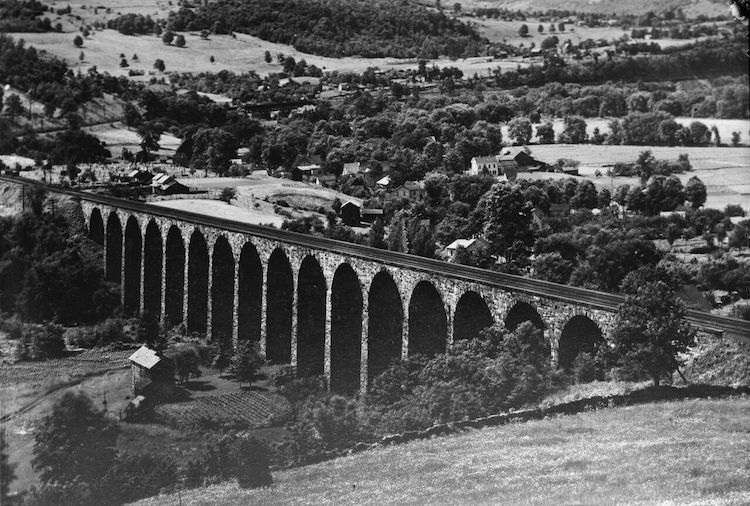
The question remained though how to unwrap these layers of thought and images that continued to fill my head. How could this possibly work? As separate works of art? Railroad viaducts? Abandoned train stations? Or a totally abstract piece inspired by street art? Or….layers? Layers of images, textures, and translucent colour. Most of my work is layered in some way so this would not be a big leap, although the varied subject matter did add a challenge.
Was there any other preparatory work?
I had been working on a series of small abstract, daily thoughts called ‘Utterance’. These small works on paper helped me as I thought about the often abstract and layered nature of street art. One artist creates their work and just by the ephemeral culture of street art, it gets painted over by another artist. Sometimes completely obliterated and sometimes parts of the previous work can still be seen.
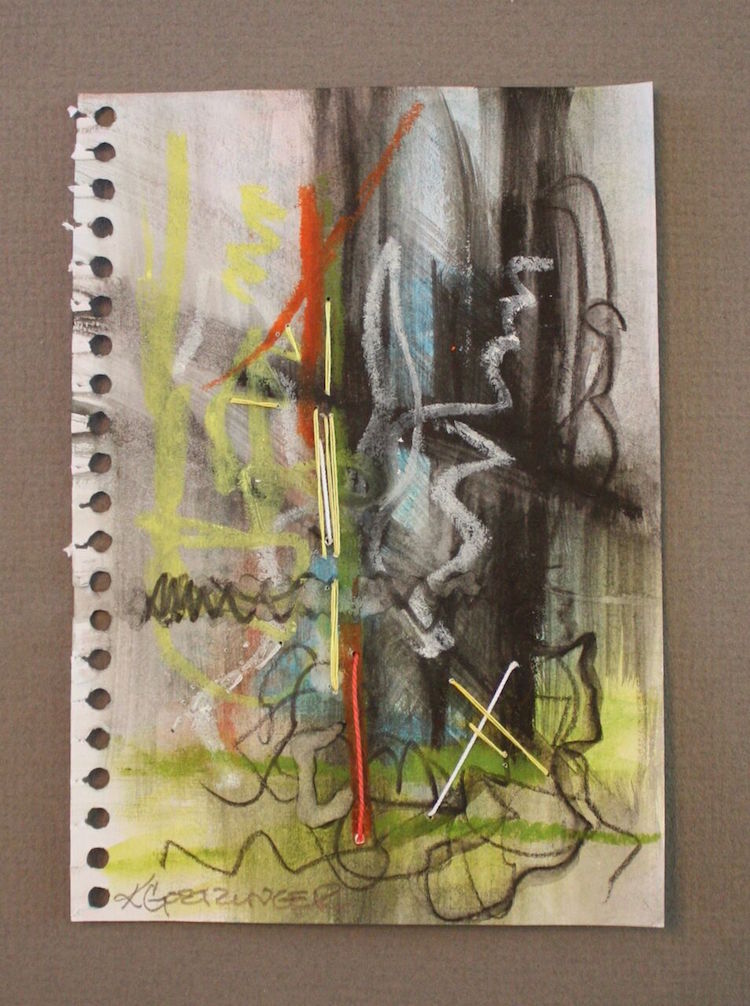
I had also recently created a few pieces called ‘Vestige’ that addressed derelict buildings. I remembered an old beautiful abandoned building that we would pass on our two-day drive back home that always intrigued me.
I did some searching on the internet and found that it was actually an abandoned train station. Perfect. So now, the task of combining all those layers of ideas, the arches of the viaducts, the street art, and the old crumbling station. I needed to simply begin and see where it would take me.
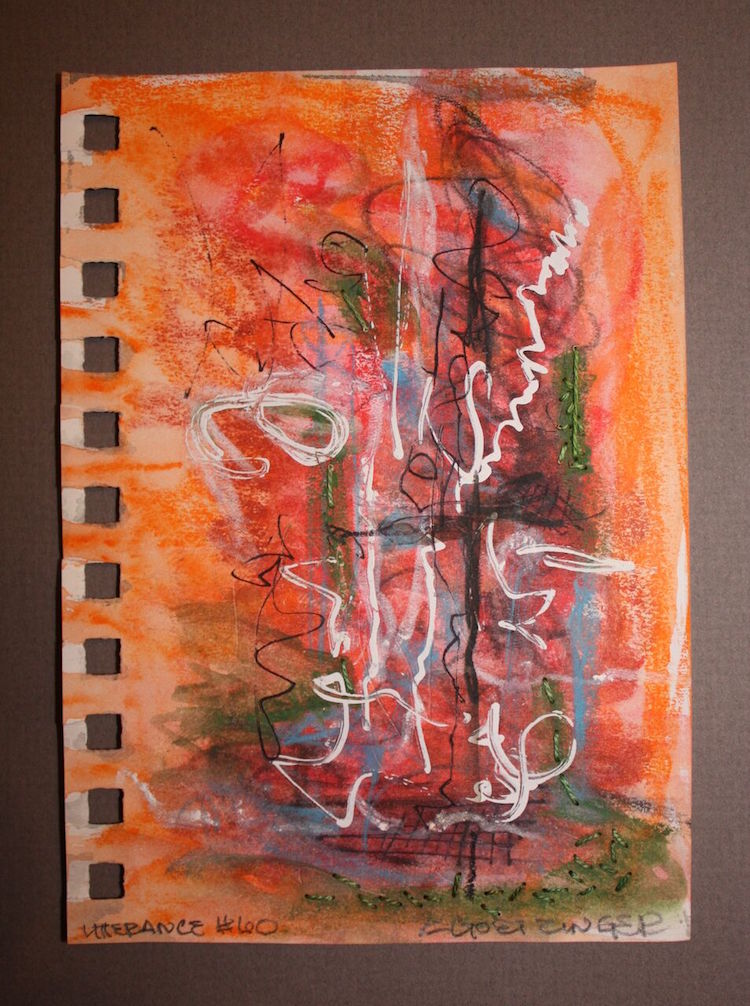
Vanishing memories
What materials were used in the creation of the piece? How did you select them? Where did you source them?
A few years ago I challenged myself to simplify the number of materials I used to create a piece. I began working with thread and acrylic paint to depict vanishing memories. I liked the ability I had to knock back the lines of drawing by embroidering with thread and painting over the stitching.
Recently though, collaged paper and fabric have slowly been reintroduced into my work. With each work I create, I carefully curate the supplies I will use, choosing only those that will best support the subject matter of the piece.
‘Travelling Exhibition 2’ was created with crochet cotton, hand dyed soy thread and acrylic paint. The soy thread is hand dyed by a local woman. I love it because of its random colour. Although she dyes in a number of stunning colours, I particularly like her thread that is essentially a black. Being hand-dyed, in a manner unique to her, it is not a solid black but a random graduation of greys, brown, black and sometimes even a dark blue.
It is perfect to help give a sketched look to the lines I stitch. Unfortunately, she is no longer able to source the soy thread, which is thicker than normal sewing thread but not as thick as crochet cotton, so once my supply is gone, I don’t know what I will do.
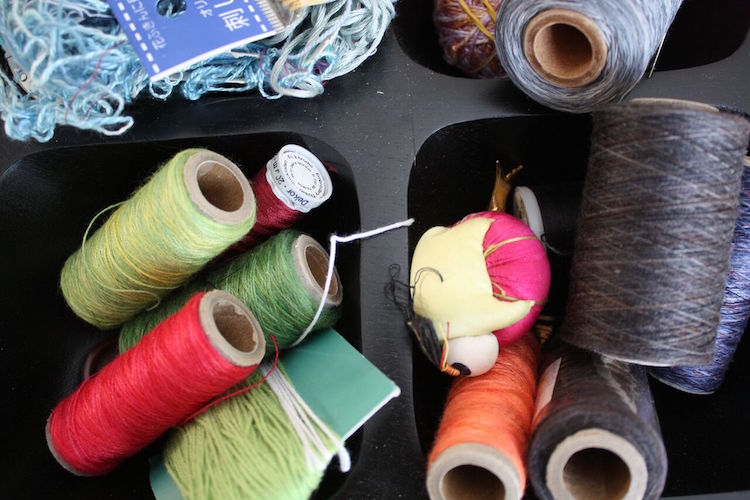
What equipment did you use in the creation of the piece and how was it used?
The equipment I used to create the piece is pretty simple, sashiko needles and a variety of sizes of artist paint brushes.
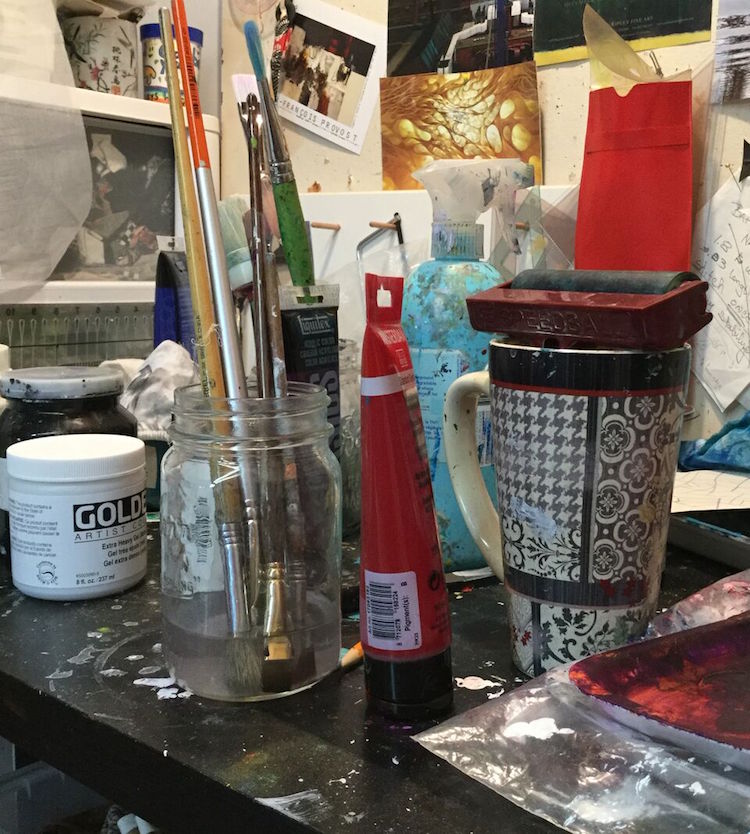
Observing the art
Take us through the creation of the piece stage by stage.
I began by sketching with pencil on the gessoed stretched canvas the series of viaducts, depicted by varying sizes of arch shapes and the subtle impression of the railroad tracks in front of a diagonal railing. These stitched lines would be painted over to make them less visible and become background texture, like a fading memory in our minds.
This initial stitching took me about 2 weeks to complete. Then came the first layer of a variety of grey-toned paints and the printing of the map shapes using a hand cut stencil.
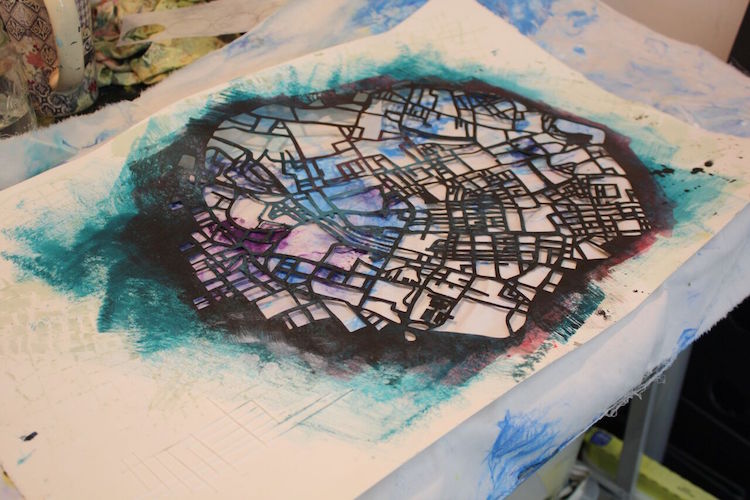
After allowing the paint to dry for a day, I painted a diagonally placed bright abstract as if it was on the side of a freight car speeding down the railroad tracks. Once the abstract painting was completed, I let the piece sit for a while as I contemplated the next step. Painting over the abstract painting seemed to be a drastic step albeit a necessary one.
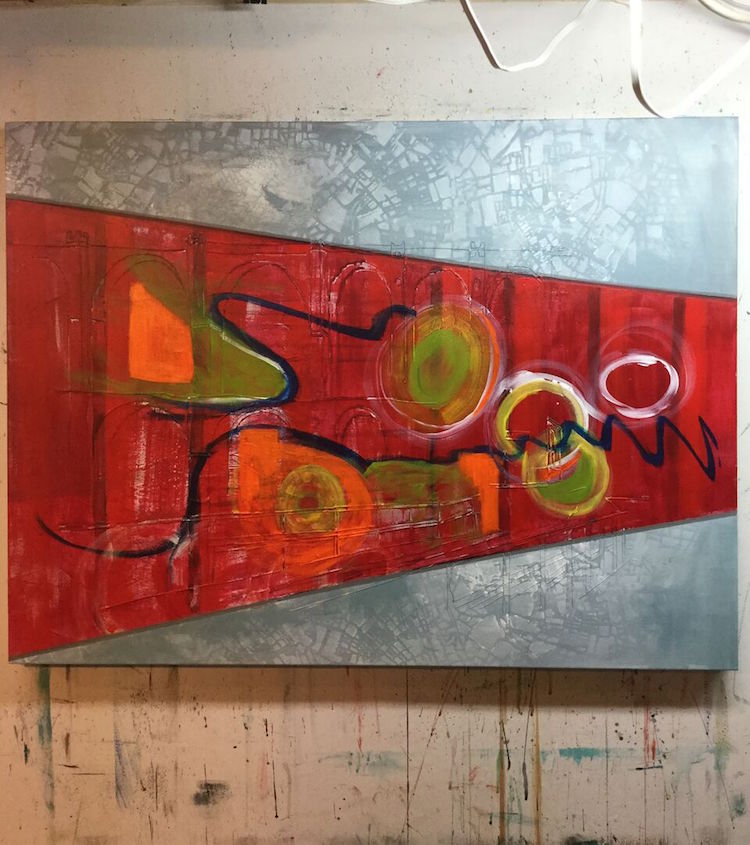
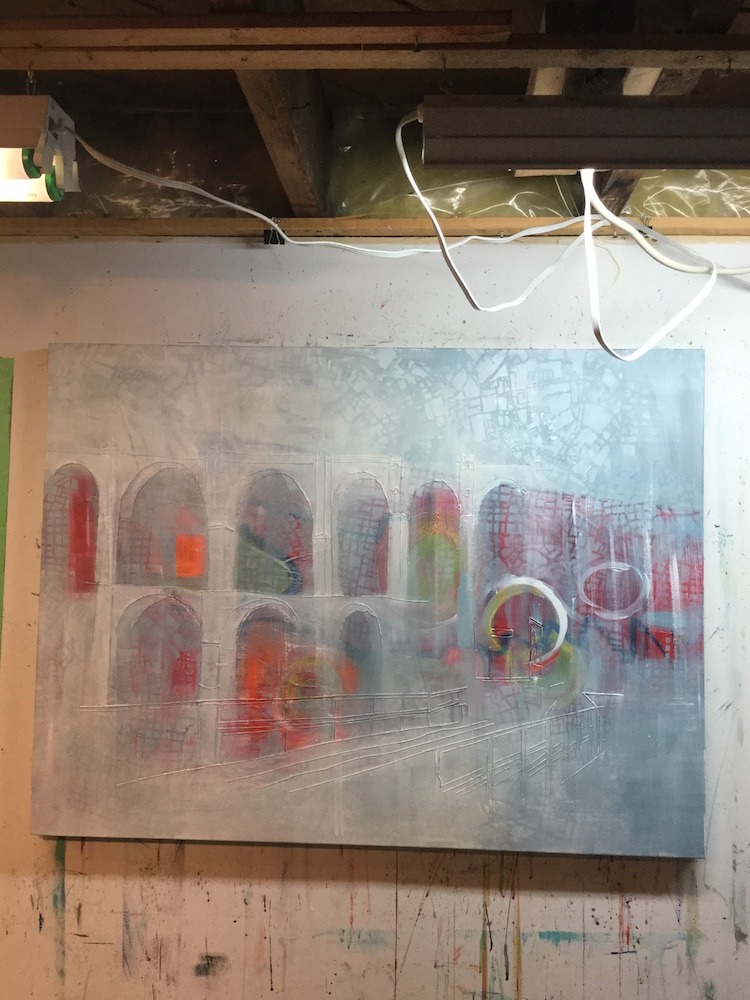
After that layer of translucent paints dried, it was time to sketch the abandoned train station onto the canvas and stitch its outlines in the hand dyed black thread. As I often do in my work about fading memories, I left out many lines that would complete the train station, to depict it’s vanishing, both physically and in our memories. These stitched lines would not be painted over but remain as the top layer of the work.
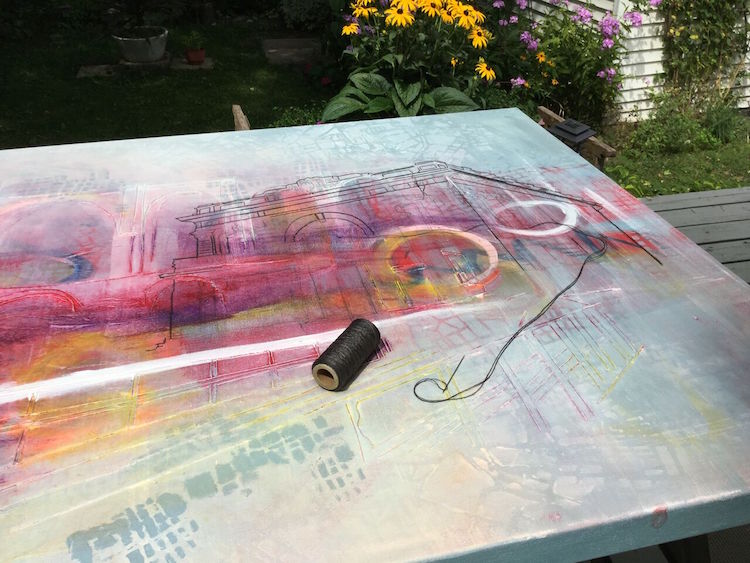
Whenever a piece is completed I let it sit a bit. I will often hang it somewhere in our house so that I can walk past it and see it in the ever-changing light of each day. I find I have a propensity for overworking my pieces so it is really important for me to step away from the brushes and observe the painting for a few days. This is when I contemplate it’s ‘doneness’.
After I make the final decision to sign it, I seal the painting with a thin coat of acrylic varnish, let it dry for a week or so and then wire it for hanging. The signing, the varnishing, and the wiring are very satisfying steps. With each completed task, I know it will soon be released into the world for others to see.
What journey has the piece been on since its creation?
‘Travelling Exhibition 2′ currently resides at Orange Art Gallery in Ottawa, Ontario, Canada but is earnestly seeking a forever home.
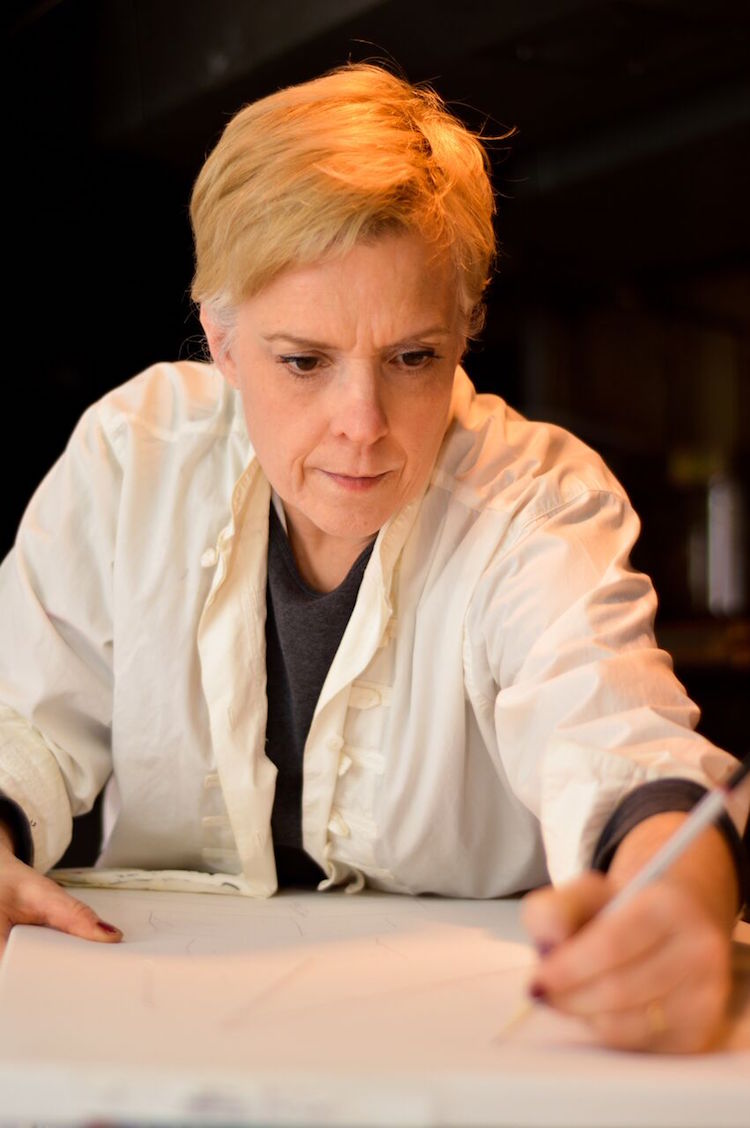
For more information visit: www.karengoetzinger.com
Let your friends know about this artist’s work by sharing the article on social media. It’s easy – click on the buttons below!
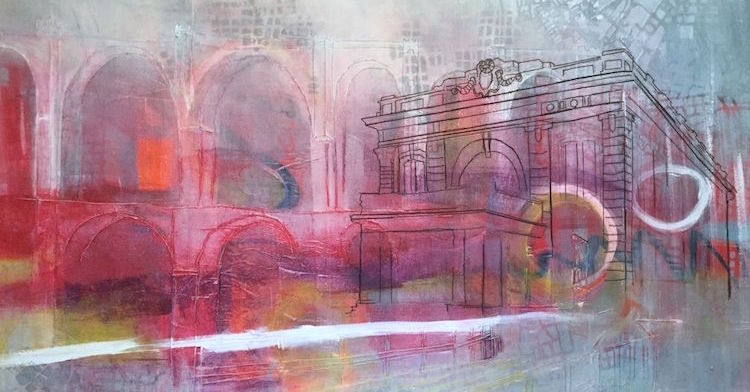

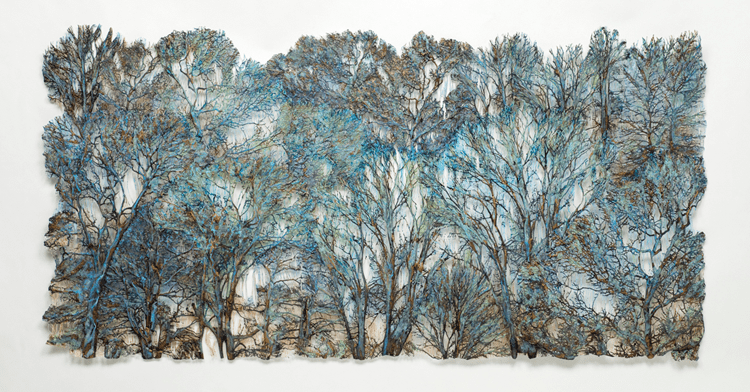
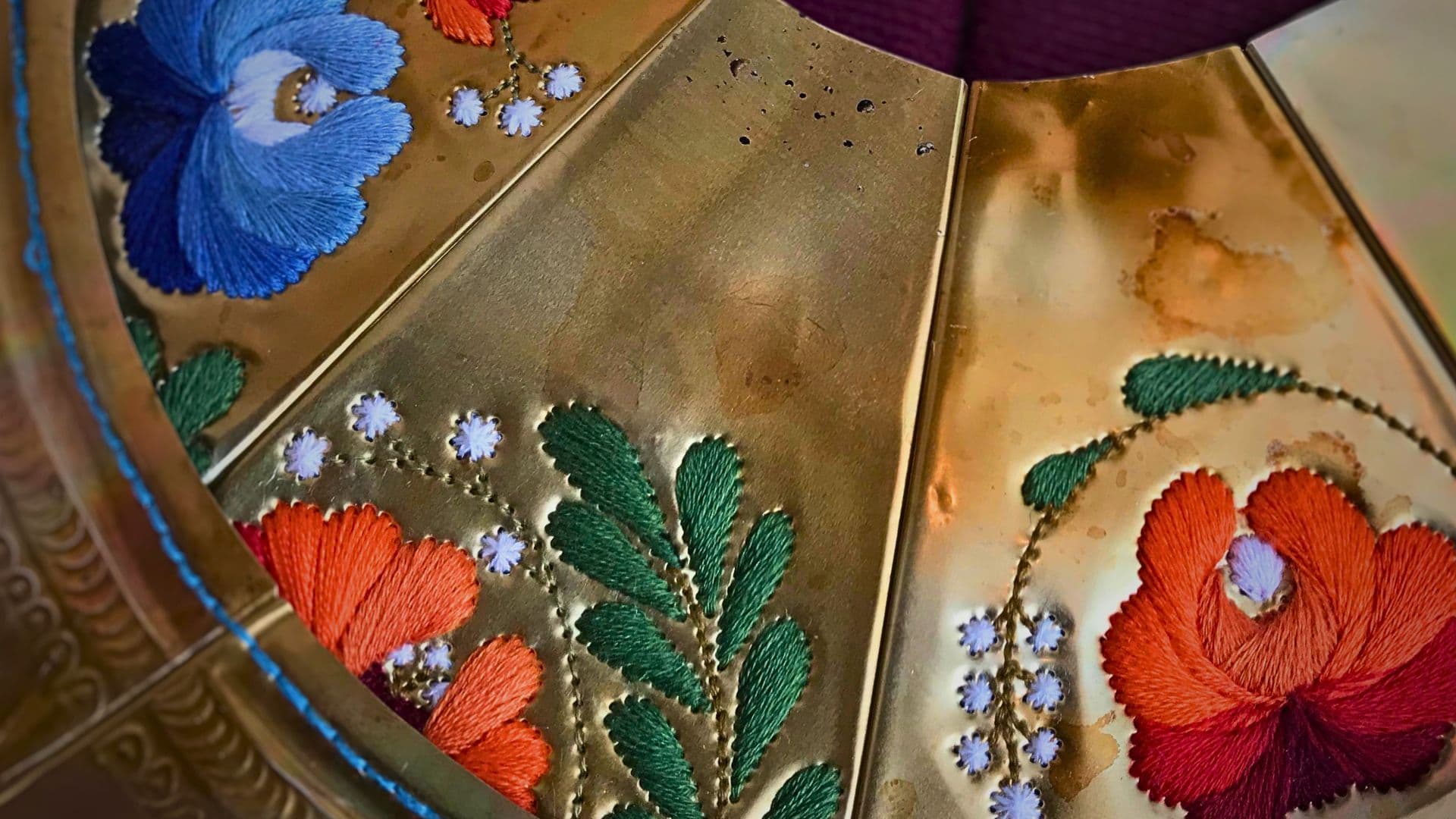
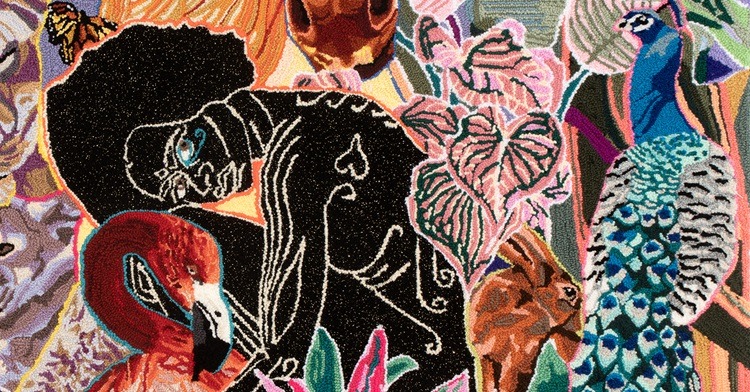
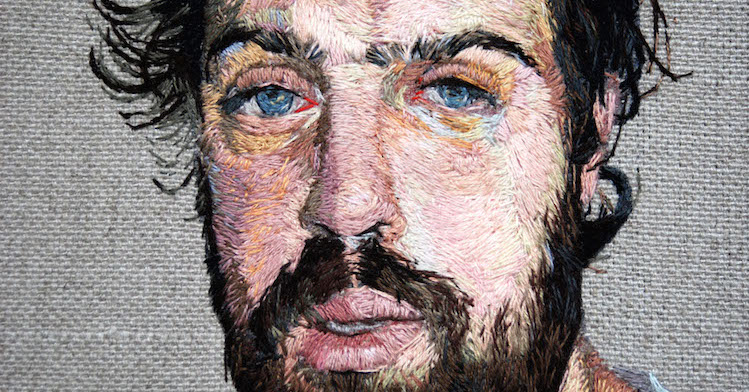
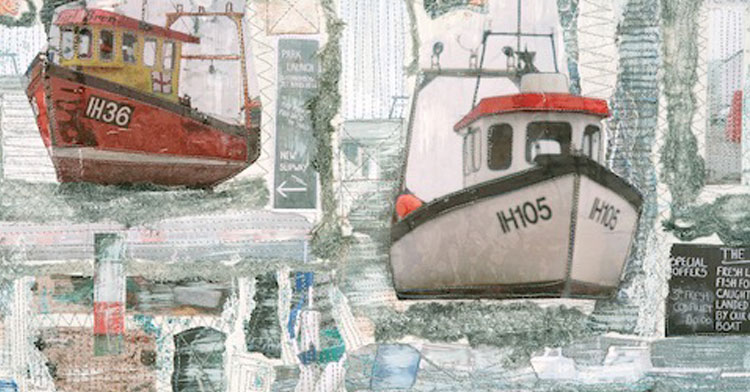
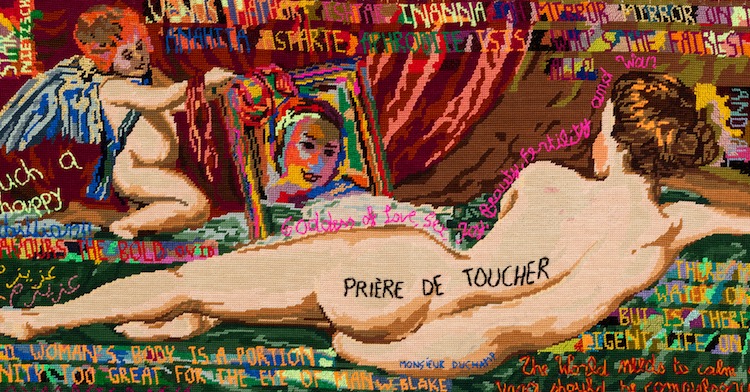
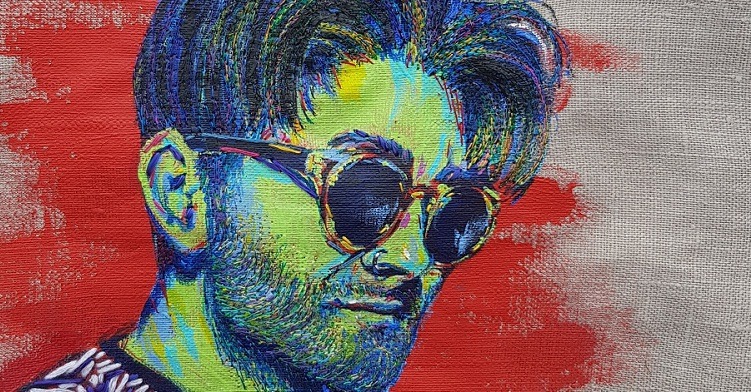
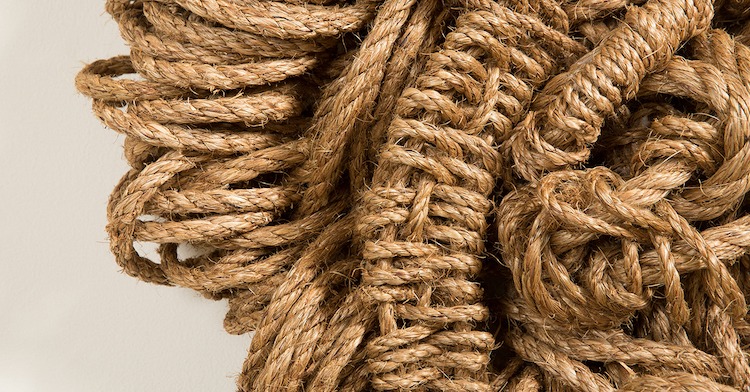
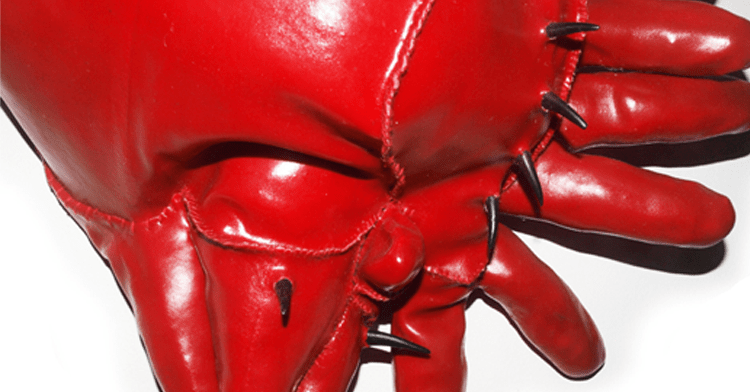
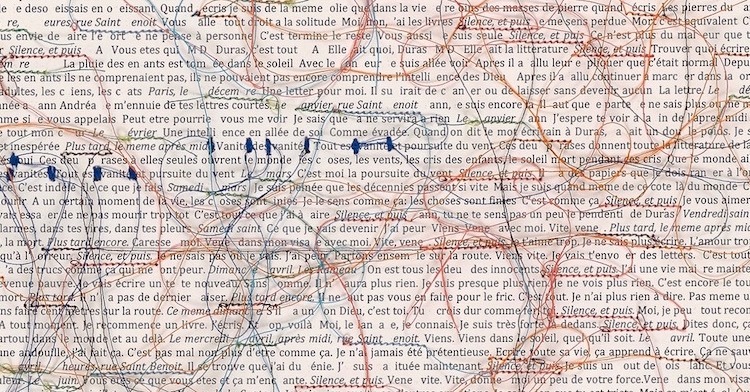
Comments